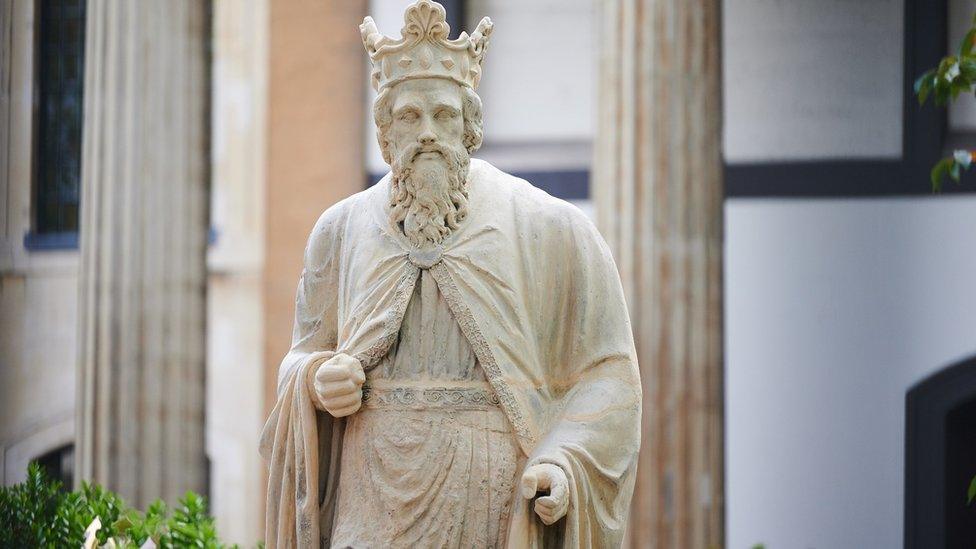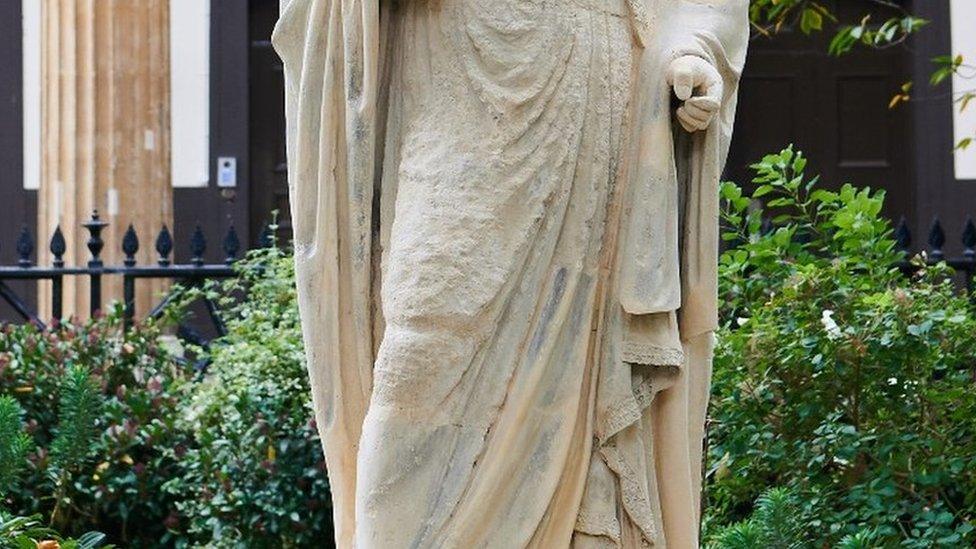Alfred the Great's Southwark statue is partly Roman goddess
- Published

Alfred the Great, in Trinity Church Square, Southwark, was thought medieval until recent conservation work
The figure considered to be the oldest outdoor statue in the capital has been found to date back even further than previously believed, to Roman times.
Alfred the Great, in Trinity Church Square, Southwark, was thought medieval until recent conservation work.
The lower half was then discovered to be Bath Stone and part of a colossal ancient sculpture dedicated to the goddess Minerva.
It is typical of the 2nd Century, dating to around the reign of Hadrian.
Prof Martin Henig, a Roman art specialist, concluded the older half is likely to have been carved by a continental craftsman used to working with British stone.
Measurements of the leg indicated the original statue was around three metres in height, "making it the most significant native stone sculpture yet to be found from Roman Britain", the Heritage of London Trust said.
Minerva, in Roman religion, was the goddess of handicrafts, the professions, the arts, and, later, war.

The newer, top half of Alfred the Great...

...and the older part of the statue, below the beltline
The top half is Coade Stone, a mix of clay, terracotta, silicates, and glass invented in the 1770s. It was fired for four days at a time in incredibly hot kilns.
Fitting the Coade Stone onto the Bath Stone would have been a complex and skilled process because the Coade Stone clay would have shrunk during firing.
Experts had theorised the statue might be one of those missing from the north face of Westminster Hall, removed by Sir John Soane in about 1825.

Bath Stone and Coade Stone
Bath Stone is what is known as a freestone - one that can be cut in any direction, unlike other rocks such as slate, which forms distinct layers. It is a golden buff colour that seems to glow in sunlight.
It is one of the many oolitic (egg-shaped) limestones formed during the Jurassic period. The Romans extensively used it on domestic, ecclesiastical and civil engineering projects.
Coade Stone is not a stone but a ceramic invented by Eleanor Coade.
Born in Exeter in 1733, the daughter of a wool merchant, she made and sold the substance. She kept the recipe and process a closely guarded secret.
By the 1760s, architects like Robert Adam were looking for a way of applying ever-more delicate ornament to their buildings.
Mrs Coade offered the most reliable way of achieving this and her stone was soon used by the leading architects of the day, including Adam, Sir William Chambers, Sir John Nash, Sir John Soane, and James Wyatt.
It proved suitable for all sorts of architectural details, but also for monuments and sculptures. It is strong and durable enough that it can still be seen across England, including at Buckingham Palace and the Brighton Pavilion.

Alfred, King of Wessex, was a defender against Viking invasion and a social reformer. Legend has it that, distracted by his problems, he allowed some cakes to burn while he was supposed to be watching them - and is roundly scolded by the woman whose baking was ruined.
For the first time, Trinity Church Square, a private garden square accessible only to local residents, will be open to the public, closing its gates again on Sunday 14 November.
The Heritage of London Trust has a programme of about 40 restoration projects across Greater London.